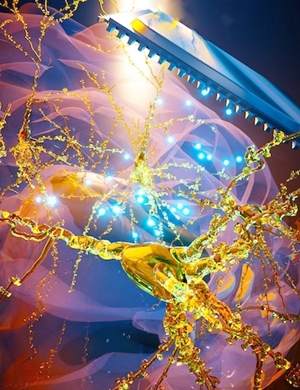|
NOVIDADES
Researchers at the Technion-Israel Institute of Technology and their partners at Bar Ilan University have developed new technology to inhibit the development of Alzheimer's disease. The work was recently published in the journal Small ("Porous Materials: Neuroprotective Effect of Nerve Growth Factor Loaded in Porous Silicon Nanostructures in an Alzheimer's Disease Model and Potential Delivery to the Brain") and also appears on the magazine cover. The research was led by Professor Ester Segal and Ph.D. student Michal Rosenberg from the Technion Faculty of Biotechnology and Food Engineering and their partners, Professor Orit Shefi and Ph.D. student Neta Zilony-Hanin from the Bar Ilan University Faculty of Engineering. Alzheimer's, the most common form of dementia, is characterized by symptoms that include memory loss, speech impairments, orientation problems, and significant impairment of motor functions. The disease primarily strikes the elderly population, and after the age of 85 reaches a prevalence of some 30%. Due to the increase in life expectancy and the increase in the elderly population, the overall incidence of the disease has grown and is today referred to as the "gray epidemic" or the "21st century plague."  Cover of the November 6, 2019 issue of Small, dedicated to the research of Prof. Ester Segal. Silicon chips are inserted into the brain of a mouse by safe implantation or with a gene gun. The chips break down while releasing a neural growth factor, a protein that prevents the death of nerve cells in Alzheimer’s disease.
Administering a specific protein, neural growth factor, inhibits the damage to the cholinergic mechanisms and the exacerbation the disease. But delivering the protein into the target area of the brain is not a simple task because the brain rests beneath the blood-brain barrier (BBB), which protects the central nervous system (the brain) from being infiltrated by bacteria and harmful substances from the blood. This barrier also restricts the passage, from the bloodstream to the brain, of drugs intended to treat brain diseases. The Technion and Bar Ilan University researchers have presented an innovative solution to this challenge: Nanoscale silicon chips for direct insertion of the protein into the brain and its release into the target tissue. The dedicated silicon chips, developed in Prof. Segal's lab, have a nanoscale porous structure that allows them to be loaded with large amounts of protein. Through precise control of chip properties –- pore dimensions, surface chemical properties and more – the researchers were able to reach an optimal configuration that retains the protein in its active form and then releases it gradually, over a period of about a month. Afterwards, the chips safely degrade in the brain and dissolve. In this way, as mentioned, the protein is not required to cross the blood-brain barrier since it is inserted directly into the brain in one of two ways: by implanting it into the brain (as a chip) or sending it to its target as microparticles with the use of a dedicated gene gun. Upon reaching the target location in the brain, the protein is released from the chip and the chip breaks down into non-toxic components. “In a series of experiments, we showed in mice that the two ways of delivering the platform into the brain led to the desired result,” said Technion doctoral student Michal Rosenberg. “Furthermore, our technology has also been tested in a cellular model of Alzheimer's disease and indeed, the protein release has led to rescuing the nerve cells.” Technion. Posted: Nov 19, 2019. |
|||||||||||||||||||||||||